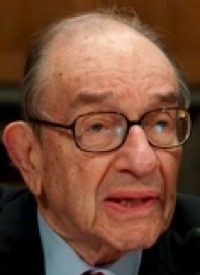
In his 48-page paper presented on March 19 to the Brookings Institution, former Federal Reserve Chairman Alan Greenspan now blames the collapse of the Soviet Union and the resurgence of the Chinese economy as causes of the Great Recession that was ushered in on his watch. And his arguments have just enough plausibility to be considered, if only briefly. But looking more closely is another matter.
When the Soviet Union collapsed, millions of workers were then free to “enter the global marketplace,” creating huge demand for consumer goods. And with the Chinese government allowing a modicum of free enterprise to placate their workers, many of them have created such significant savings that many billions of dollars were looking for a home. And consequently, many of those dollars returned to the United States in the form of mortgage capital that helped fund the housing boom. Greenspan said, “In short, geopolitical events ultimately led to a fall in long-term mortgage interest rates that in turn led, with a lag, to the unsustainable boom in house prices globally.”
Looking more closely, however, reveals perhaps more of an interest in deflecting criticism for his role in creating the housing bubble and in burnishing his image which has faded in recent years.
He initially denied that the Fed’s policy of low interest rates following the dot-com bust had anything to do with the housing bubble. He explained, “We had been lulled into a sense of complacency by the only modestly negative economic aftermaths of the stock market crash of 1987 and the dot-com boom. Given history, we believed that any declines in home prices would be gradual. Destabilizing debt problems were not perceived to arise under those conditions.” Later on in the article he conceded that the low fed funds rate made it easier for borrowers to use adjustable-rate mortgages and that “the global house price bubble was a consequence of [those] lower rates.”
He further compounded his implausible denial that the Fed had an impact on the bubble by suggesting that even if the Fed had known about it, it wouldn’t have been able to do anything about it anyway. William White, the chief economist at the Bank for International Settlements, challenged Greenspan as early as 1996 that central banks could resist potential bubbles by a change [tightening] in monetary policy. White recommended to Greenspan that he “raise interest rates when credit expands too fast.” Greenspan disagreed, saying, “There has never been an instance, of which I’m aware, that leaning against the wind was successfully done.”
Instead, Greenspan insisted that since it was impossible for him, or any other Federal Reserve chairman, to anticipate such bubbles, it would be better to institute additional regulations regarding capital requirements which would reduce the “moral hazard” that drove so many financial institutions into making risking loans, knowing that the Fed was always going to be there to back them up and relieve them of the consequences of their poor investment decisions. Greenspan put it this way: “The notion of an effective systemic regulator as part of the regulatory reform package is ill-advised. Forecasters as a group will almost certainly miss the onset of the next financial crisis as they have so often in the past, and I presume any newly designated systemic risk regulator will also.” (Emphasis added.)
In plain English, Greenspan denies culpability for the housing bubble and claims that he never saw it coming — and neither will anyone else when it happens again.
Fortunately, YouTube and the Internet have a way of “clarifying” such dismissals of innocence and ignorance. At a Joint Economic Committee Meeting in April of 2002, Greenspan said, “The ongoing strength in the housing market has raised concerns about the possible emergence of a bubble in home prices. However, the analogy made to the building and bursting of a stock price bubble is imperfect…. Even if a bubble were to develop in a local [real estate] market, it would not necessarily have implications for the nation as a whole.”
In June of 2004, Greenspan had another opportunity to address the looming bubble at a Senate hearing. He said, “Well, it is certainly the case…that prices have been moving up faster than they have been … but not enough in our judgment to raise major concerns. It could become a problem, if it were to accelerate further. We see little evidence that that’s likely to happen.” And in October of that year, he spoke at America’s Community Bankers Annual Convention, saying, “These concerns [about a bubble] cannot be readily dismissed. Debt leverage of all types is often troublesome when one judges the stability of the economy. Should home prices fall, we would have reason to be concerned about mortgage debt, but measures of household financial stress do not, at least to date, appear overly worrisome.”
By 2007, Greenspan began to see housing prices start to fall, and predicted “large double digit declines [in housing prices] larger than most people expect.”
Not only did Greenspan go through the steps of denial, excuse, deferral, and finally acceptance of the housing bubble, he knew exactly the consequences of the Fed’s action long before he ever took over as Fed chair in 1987. His Ph.D. thesis which he wrote in 1977, the year he received his economics degree from New York University, had been removed from NYU’s Bobst library at his request when President Reagan appointed him to the Fed. Barron’s magazine turned up a copy, however, in April of 2008, and commented on it extensively. Said Barron’s, “We were tickled to find that the work’s introduction includes a discussion of soaring housing prices and their effect on consumer spending; it even anticipates a bursting housing bubble.” (Emphasis added.) Quoting Greenspan in his thesis, “There is no perpetual motion machine which generates an ever-rising path for the prices of homes.” He noted that during a housing bubble, homeowners would refinance “for larger amounts than their original mortgage, in essence monetizing increases in their home’s market value and spending [it].”
Greenspan’s implausible denial goes back even further. While studying economics at NYU and Columbia in the late ‘40’s, he also began studying under Ayn Rand and was “converted to Rand’s philosophy of Objectivism by her associate Nathanial Branden.” He wrote several essays that appeared in Rand’s book, Capitalism: the Unknown Ideal, including one entitled “Gold and Economic Freedom.” In that essay, Greenspan clearly identifies the need for a gold standard to keep government spending under control. He wrote, “Opposition to the gold standard in any form was prompted by a much subtler insight: the realization that the gold standard is incompatible with chronic deficit spending (the hallmark of the welfare state). Stripped of its academic jargon, the welfare state is nothing more than a mechanism by which governments confiscate the wealth of the productive members of a society to support a wide variety of welfare schemes. A substantial part of the confiscation is effected by taxation. But the welfare statists were quick to recognize that if they wished to retain political power, the amount of taxation had to be limited and they had to resort to programs of massive deficit spending, i.e., they had to borrow money, by issuing government bonds, to finance welfare expenditures on a large scale.” He goes on to say:
Government deficit spending under a gold standard is severely limited. The abandonment of the gold standard made it possible for the welfare statists to use the banking system as a means to an unlimited expansion of credit. They have created paper reserves in the form of government bonds which — through a complex series of steps — the banks accept in place of tangible assets and treat as if they were an actual deposit, i.e., as the equivalent of what was formerly a deposit of gold. The holder of a government bond or of a bank deposit created by paper reserves believes that he has a valid claim on a real asset. But the fact is that there are now more claims outstanding than real assets. The law of supply and demand is not to be conned. As the supply of money (of claims) increases relative to the supply of tangible assets in the economy, prices must eventually rise. Thus the earnings saved by the productive members of the society lose value in terms of goods. When the economy’s books are finally balanced, one finds that this loss in value represents the goods purchased by the government for welfare or other purposes with the money proceeds of the government bonds financed by bank credit expansion.
Greenspan concludes, “This is the shabby secret of the welfare statist’s tirades against gold. Deficit spending is simply a scheme for the confiscation of wealth. Gold stands in the way of this insidious process.”
There is even a YouTube video of Greenspan explaining clearly his position on the importance of the gold standard, and his compromise with it when he became Fed chair.
In a review of Ron Paul’s book End the Fed (here), Charles Scaliger points out, “According to Dr. Paul [the Fed] has been complicit in — indeed, has been the driving engine for — the supersizing of the federal government that has transformed America since the First World War. This is because the Federal Reserve, with its ability to artificially increase the money supply (especially after the gold standard was abandoned) has largely emancipated Washington decision makers from the risky politics of raising revenue via direct taxation.”
Scaliger continues: “Somewhere along the line, Greenspan the theorist and moral philosopher yielded to Greenspan the pragmatist.” And so Greenspan’s implausible denial of responsibility for the housing bubble and subsequent Great Recession is merely another example of trying to defend a fundamentally dishonest, immoral, and unconstitutional institution, the Federal Reserve System.



